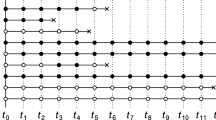Abstract
In epidemiologic studies, measurement error in the exposure variable can have a detrimental effect on the power of hypothesis testing for detecting the impact of exposure in the development of a disease. To adjust for misclassification in the hypothesis testing procedure involving a misclassified binary exposure variable, we consider a retrospective case–control scenario under the assumption of nondifferential misclassification. We develop a test under Bayesian approach from a posterior distribution generated by a MCMC algorithm and a normal prior under realistic assumptions. We compared this test with an equivalent likelihood ratio test developed under the frequentist approach, using various simulated settings and in the presence or the absence of validation data. In our simulations, we considered varying degrees of sensitivity, specificity, sample sizes, exposure prevalence, and proportion of unvalidated and validated data. In these scenarios, our simulation study shows that the adjusted model (with-validation data model) is always better than the unadjusted model (without validation data model). However, we showed that exception is possible in the fixed budget scenario where collection of the validation data requires a much higher cost. We also showed that both Bayesian and frequentist hypothesis testing procedures reach the same conclusions for the scenarios under consideration. The Bayesian approach is, however, computationally more stable in rare exposure contexts. A real case–control study was used to show the application of the hypothesis testing procedures under consideration.





Similar content being viewed by others
References
Brenner H (1996) Correcting for exposure misclassification using an alloyed gold standard. Epidemiology 7:406–410
Breslow N, Cain K (1988) Logistic regression for two-stage case-control data. Biometrika 75(1):11–20
Chu R, Gustafson P, Le N (2010) Bayesian adjustment for exposure misclassification in case–control studies. Stat Med 29(9):994–1003
Copeland K, Checkoway H, McMichael A, Holbrook R (1977) Bias due to misclassification in the estimation of relative risk. Am J Epidemiol 105(5):488–495
Gelder M, Donders A, Devine O, Roeleveld N, Reefhuis J (2014) Using bayesian models to assess the effects of under-reporting of cannabis use on the association with birth defects, national birth defects prevention study, 1997–2005. Paediatr Perinat Epidemiol 28(5):424–433
Greenland S (1988a) Statistical uncertainty due to misclassification: implications for validation substudies. J Clin Epidemiol 41(12):1167–1174
Greenland S (1988b) Variance estimation for epidemiologic effect estimates under misclassification. Stat Med 7(7):745–757
Greenland S (2001) Sensitivity analysis, monte carlo risk analysis, and bayesian uncertainty assessment. Risk Anal 21(4):579–584
Greenland S (2008) Maximum-likelihood and closed-form estimators of epidemiologic measures under misclassification. J Stat Plan Inference 138(2):528–538
Greenland S, Gustafson P (2006) Accounting for independent nondifferential misclassification does not increase certainty that an observed association is in the correct direction. Am J Epidemiol 164(1):63–68
Gustafson P (2004) Measurement error and misclassification in statistics and epidemiology: impacts and Bayesian adjustments. CRC, Boca Raton
Gustafson P (2014) Bayesian statistical methodology for observational health sciences data. Can Outlook Stat Action 163:1149
Gustafson P, Greenland S (2006) Curious phenomena in Bayesian adjustment for exposure misclassification. Stat Med 25(1):87–103
Gustafson P, Greenland S (2014) Misclassification. Handbook of epidemiology. Springer, Berlin, pp 639–658
Gustafson P, Karim M (2015) When exposure is subject to nondifferential misclassification, are validation data helpful in testing for an exposure-disease association?
Gustafson P, McCandless L (2010) Probabilistic approaches to better quantifying the results of epidemiologic studies. Int J Environ Res Public Health 7(4):1520–1539
Gustafson P, McCandless L (2014) Commentary: priors, parameters, and probability: a bayesian perspective on sensitivity analysis. Epidemiology 25(6):910–912
Holcroft C, Spiegelman D (1999) Design of validation studies for estimating the odds ratio of exposure-disease relationships when exposure is misclassified. Biometrics 55(4):1193–1201
Kraus J, Greenland S, Bulterys M (1989) Risk factors for sudden infant death syndrome in the US Collaborative Perinatal Project. Int J Epidemiol 18(1):113–120
Ladouceur M, Rahme E, Pineau C, Joseph L (2007) Robustness of prevalence estimates derived from misclassified data from administrative databases. Biometrics 63(1):272–279
Lash T, Fox M, Fink A (2011) Applying quantitative bias analysis to epidemiologic data. Springer, Berlin
Mak T, Best N, Rushton L (2015) Robust bayesian sensitivity analysis for case-control studies with uncertain exposure misclassification probabilities. Int J Biostat 11(1):135–149
Marshall R (1990) Validation study methods for estimating exposure proportions and odds ratios with misclassified data. J Clin Epidemiol 43(9):941–947
Marshall R (1997) Assessment of exposure misclassification bias in case-control studies using validation data. J Clin Epidemiol 50(1):15–19
McInturff P, Johnson W, Cowling D, Gardner I (2004) Modelling risk when binary outcomes are subject to error. Stat Med 23(7):1095–1109
Palmgren J (1987) Precision of double sampling estimators for comparing two probabilities. Biometrika 74(4):687–694
Prescott G, Garthwaite P (2002) A simple Bayesian analysis of misclassified binary data with a validation substudy. Biometrics 58(2):454–458
Rothman KJ, Greenland S, Lash TL (2008) Modern epidemiology. Lippincott Williams & Wilkins, Philadelphia
Spiegelman D (1994) Cost-efficient study designs for relative risk modeling with covariate measurement error. J Stat Plan Inference 42(1):187–208
Tosteson T, Ware J (1990) Designing a logistic regression study using surrogate measures for exposure and outcome. Biometrika 77(1):11–21
Youden W (1950) Index for rating diagnostic tests. Cancer 3(1):32–35
Zelen M, Haitovsky Y (1991) Testing hypotheses with binary data subject to misclassification errors: analysis and experimental design. Biometrika 78(4):857–865
Author information
Authors and Affiliations
Corresponding author
Electronic supplementary material
Below is the link to the electronic supplementary material.
Rights and permissions
About this article
Cite this article
Karim, M.E., Gustafson, P. Hypothesis Testing for an Exposure–Disease Association in Case–Control Studies Under Nondifferential Exposure Misclassification in the Presence of Validation Data: Bayesian and Frequentist Adjustments. Stat Biosci 8, 234–252 (2016). https://doi.org/10.1007/s12561-015-9141-9
Received:
Revised:
Accepted:
Published:
Issue Date:
DOI: https://doi.org/10.1007/s12561-015-9141-9




